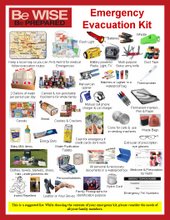
Tuesday, July 24, 2007
Monday, July 23, 2007
Survival Kit
Survival kit is a package of basic tools and supplies prepared in advance as an aid to survival in an emergency. Survival kits contain supplies and tools to provide a person with basic shelter against the elements and keep warm, meet their health and first aid needs, provide food and water, signal to rescuers, and assist them in finding their way back to help.
The specific supplies or tools that fit in each of these categories are listed below. Note that the list below is not the contents of an actual survival kit. Rather, each category lists some of the supplies or tools from which kit-makers choose when they are making a survival kit:
The specific supplies or tools that fit in each of these categories are listed below. Note that the list below is not the contents of an actual survival kit. Rather, each category lists some of the supplies or tools from which kit-makers choose when they are making a survival kit:
Shelter or warmth
- Reflective aluminum Space blanket to retain body heat
- Lightweight emergency poncho for protection against rain
- Emergency "tube tent", "bivvy bag" or tarp with grommets for attaching a rope
- Magnifying glass, magnesium, or tinder for fire-starting
- Mosquito net, protection against mosquitoes, flies and other insects.
- Magnesium Flint and Saw Striker
- Waterproof matches or lighter
- Esbit or heat tablets for starting a fire
- Dark-colored Shoe Polish(Black preferred) for fire fuel. (it also gives off a smell that can repel animals and can be used for marking and camouflage)
- Cable saw for cutting wood (either for constructing a shelter or for a fire)
Health and First Aid
- First aid kit with bandages, sterile pads and gauze, first aid tape, tweezers, surgical razor, disinfectant pads, oxytetracycline tablets (for diarrhea or infection) and aspirin
- Insect repellent
- Soap
- Toilet paper
- Lip balm
Food and water
- Iodine tablets for emergency water purification
- Edible salt for food and also can be used for brushing teeth.
- Water in bottles or tetra blocs
- Collapsible (empty) water bags or containers
- Canned food, Ready-to-eat meals (MRE), or high-energy foods such as chocolate or emergency food bars.
- Fishing line, fish hooks, lures, and split shot leads
- Snare wire
- Tea, gum, and hard candy (as a morale booster)
Signaling, navigation and reference
- Emergency Position-Indicating Radio Beacons (EPIRB) send a distress signal that allows the beacon to be located by a satellite system, minimizing the search and maximizing the rescue.
- Candles, Torch (flashlight), or glow sticks
- Surveyor's orange tape (for marking location for rescuers)
- Pen and paper (for leaving notes to rescuers about direction of travel)
- Whistle, Mirror, and/or smoke or illumination flares for signaling
- Compass, GPS navigation equipment
- Maps of the region
- Survival manual
Multipurpose tools or materials
- Swiss army style knife
- Gerber or Leatherman style multi tool
- sharpening stone
- Folding saw or cable saw
- Heavy-duty thread and needle (for repairing clothing and equipment)
- Plastic bags or trash bags
- Heavy-duty aluminum foil (for frying food, signaling, etc.)
- Sturdy cord or "550" parachute cord (for supporting a tarp, snaring small animals, etc.)
- Firearm, preferably a 12 gauge shotgun(for food procurement and signaling), plus 150 rounds of ammunition (25 rds "00" Buckshot, balance in small game loads)
Subscribe to:
Comments (Atom)

